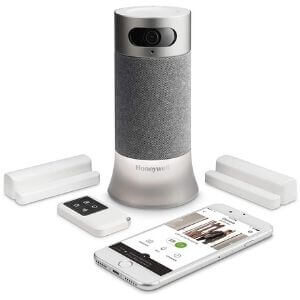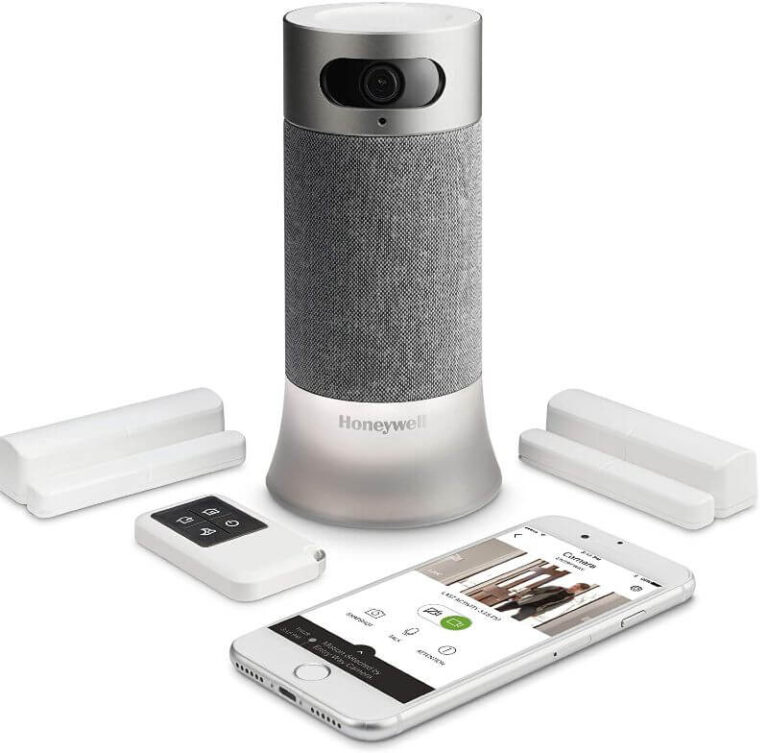Honeywell Smart Home Security's most prominent aspects are the base station's built-in security camera and Amazon Alexa voice assistant. While the camera isn't a unique feature—Canary and Abode Iota offer similar features—the built-in Alexa controls offer more options.
Because the unit has Alexa, you can use it as an Echo smart speaker to play music, ask questions, and control smart home devices. Considering the device costs more than a standard Echo and doesn’t play music as clearly, this is underwhelming, but the Alexa speaker aspect is still secondary to its security functions.
Light-up base
The Camera Base Station has colored lights on the bottom to show you the system's status. Green lights show that the system is active in away mode, while purple indicates night mode (which only monitors door and window sensors). Other colors and regular flashes share additional information about your system.
No professional monitoring
Honeywell Smart Home Security doesn't have a professional monitoring option to contact the police when someone triggers the system. While it used to be the norm for DIY security systems to forego professional monitoring, it's increasingly uncommon now.
Without professional monitoring, you need to stay on top of everything in your home. The system can help you know when to call for help, but the responsibility—and pressure—is yours.
The Honeywell Home mobile app works well enough but doesn't stand out compared to other security apps. It includes many useful features like arming controls, geofencing, two-way audio, and facial recognition. Of these, we like the geofencing for automatically arming and disarming the system as you leave or arrive at home. Geofencing isn't as revolutionary as it was five years ago, but it seems to be the best Honeywell Home has to offer.
Honeywell's facial recognition feature is cool in concept, but it has severe limitations. It doesn't store more than two faces and tracks those faces for just two hours each day, making for an underwhelming experience. We're not even sure if facial recognition could be helpful under these conditions.
Based on user reviews in the App Store and on Google Play, the app can sometimes be unstable, with Android users offering more criticism on average. A bright spot is that Honeywell Home's parent company—Resideo—takes an active role in addressing issues that users bring up in reviews. This is something we immediately saw when we started reading through user reviews.
The camera in the Honeywell Smart Home Security sports 1080p video resolution, live video streaming, and records a 30-second video clip when it detects motion. It doesn't offer other recording modes like scheduled recording and continuous recording.
Even without other recording modes, the camera allows you to set up custom zones to help you monitor a particular door, window, or high-traffic area. Setting up a zone can reduce false alerts from pets or ceiling fans. The motion-sensing feature also has an adjustable sensitivity setting to ignore small movements like a cat grooming on the couch in favor of larger actions like an uninvited guest walking through the room.
The video quality of daytime and night vision recordings is clear enough to distinguish details, but it's average among security cameras. We like that the camera has a privacy ring around the top that you can rotate to prevent the camera from recording video. It can keep the camera from slowing down your Wi-Fi network with unnecessary recordings.
Alerts and siren
Depending on how you arm the system, the Honeywell Smart Home Security can send a push notification to your smartphone or sound a siren to deter intruders.
The free cloud storage is useful, but its 24-hour video history is probably a bit too short for folks who don't want to peruse recordings once a day. If you want a more hands-off storage option, you can upgrade to a Honeywell Home Membership for significantly more storage.
Although the Standard Membership comes with 30 days of cloud storage, it covers only a single camera for $4.99 a month, which is pricey compared to single-camera plans from Arlo and Wyze that clock in at around $3 or less per month. Honeywell Home also lags behind competitors by restricting video clips to 30 seconds—even on the paid plan—instead of recording all activity from start to finish.
You can have unlimited cameras (and 60 days of storage) if you upgrade to the pricier Premium Membership for $14.99 a month, but that doesn't hold up to similar offerings like Nest Aware ($6 a month) and Ring Protect Plus ($10 a month).
Overall, Honeywell Home can't keep up with other competitors on cloud storage, which puts it at a huge disadvantage. We think a price drop or added features could close the gap, but it's not worth the extra cost for now.
Accessories in the starter kit
Although the Camera Base Station is the heart of the system, we like that you can link it to external accessories and sensors to improve your security. The starter kit comes with two such accessories—an access sensor and a key fob.
- The access sensor attaches to doors and windows to track when they open and close—allowing an automatic alarm to trigger a siren and send alerts. The starter kit includes two access sensors.
- The key fob is a small remote that you use to arm the system, similar to most cars' key fobs. It's handy for quickly adjusting the system settings without reaching for your phone.






